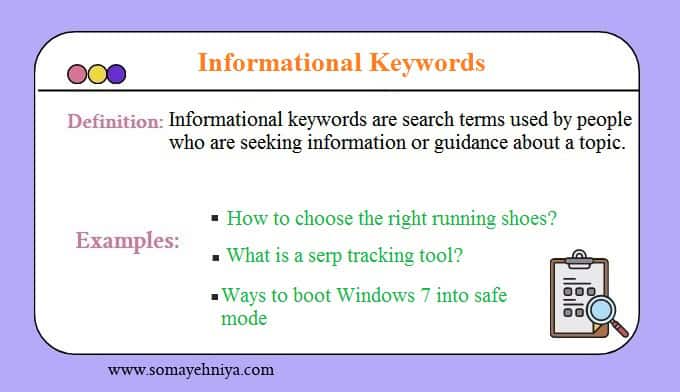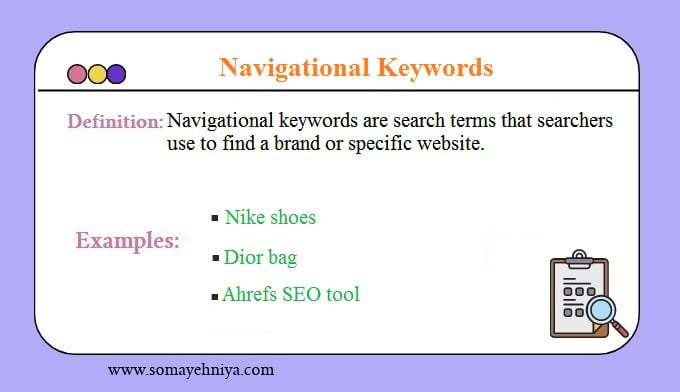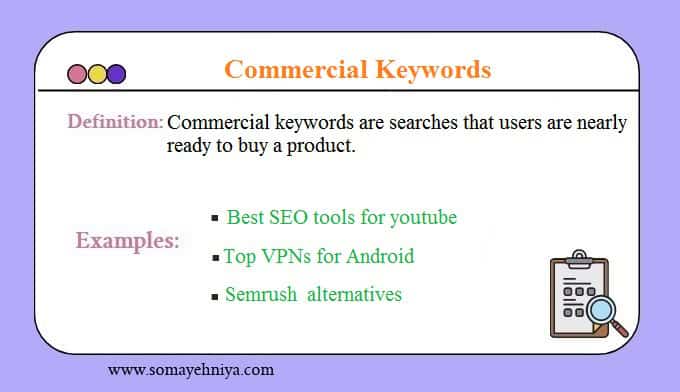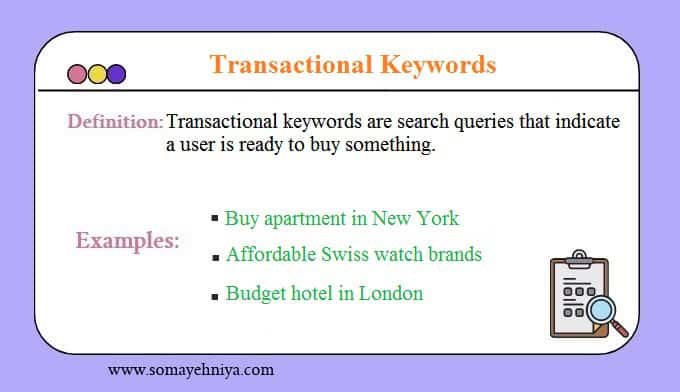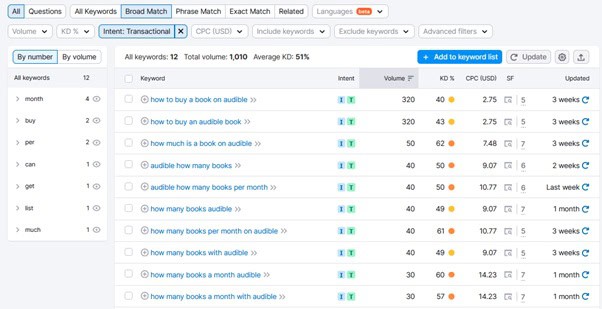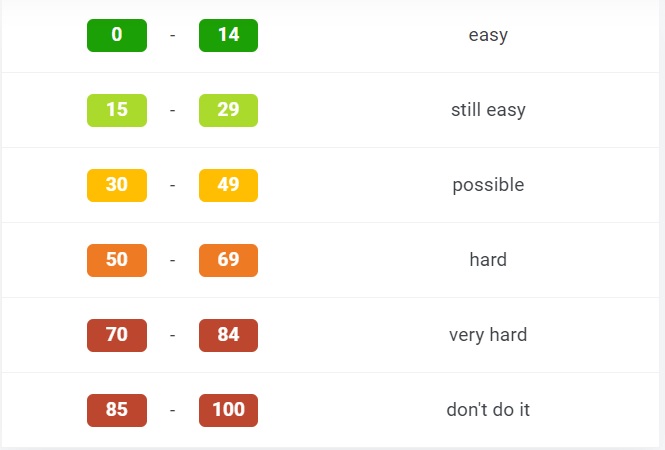23 Types of Keywords in SEO: +How to Find, Analyze and Use
- Somayeh Niya
- July 31, 2023
- Updated on: May 25, 2024
If you imagine SEO is a building, keywords are the foundation of this building.
Choosing wrong keywords leads you to the below results:
–Your page doesn’t rank by Google
–You call the wrong users to the page
So, the first step to finding the right keywords is knowing the different types of keywords in SEO.
In this article, I will discuss different types of keywords in SEO, how to use and find them, and more.
What is a keyword in SEO?
A keyword is a word or phrase people use for searching about a specific topic in search engines.
For example, imagine you have a website for selling dog foods. Your keywords are what people type in search engines to buy your products. Depending on the type of food you sell and customer’s questions, your keyword varies.
Why are keywords important in SEO?
When a user type a query in search bar, Google bots try to find the most relevant content. If Google doesn’t do it well, most probably lose users after some wrong results. So, keywords are super important for search engines.
That makes sense.
On the other hand, the main goal of every website is to acquire organic traffic. No one likes to pay for ads to gain traffic. Regardless of wasting money, paid traffic isn’t permanent and doesn’t bring authority to you. So, right keywords are crucial for creating perfect content marketing to drive organic traffic to the website.
To find the right keyword consider below steps:
- Learn different types of keywords
- Make a keywords list
- Analyze keywords
- Use keywords in the best places of content
Understanding the different types of keywords for SEO and how they work together is crucial for successful SEO strategies. By incorporating a variety of keywords into your content, you can improve your website’s visibility and attract more organic traffic.
Lets’ start!
Types of keywords in SEO: By length
Length of keywords is important in search engine optimization (SEO). Different lengths of keywords serve different purposes and have varying levels of competition.
Let’s take a closer look at these types of keywords in SEO based on length.
- Short-tail
- Mid-tail
- Long-tail
Short-Tail Keywords
As the name implies, a short tail keyword consists of one or two words. These keywords are highly generic and broad. Due to their broadness, short-tail keywords often face intense competition, and ranking well for them can be challenging.
So, if your website doesn’t have high domain authority, it’s better to forget these types of keywords
For example, “shoes” or “SEO” are considered short-tail keywords. While they may bring traffic for websites with high DA, the conversion rate may be relatively low. Because users who search for this type of inquiry, don’t have the decision to buy any product.
Short-tail keywords characteristics:
- 1 or 2 words
- High search volume
- Vague user intent
- High competition
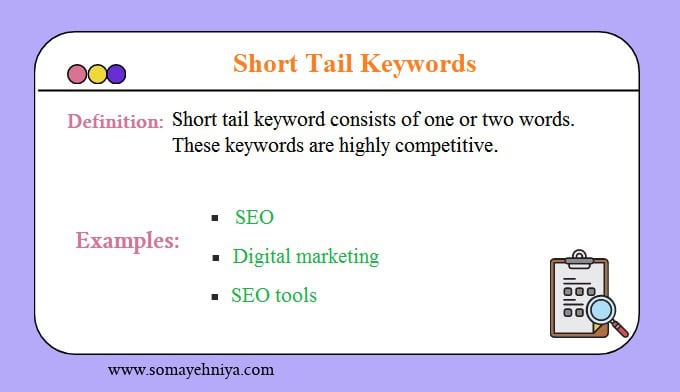
How to use short-tail keywords: Using short-tail keywords isn’t recommended if you don’t have a strong and well-established site in your niche. Although they have a very high search volume, winning the competition isn’t possible for every website.
Mid-tail Keywords
As the name suggests, mid-tail keywords fall between short-tail and long-tail keywords in terms of length and specificity. They provide a balance between search volume and relevance.
For example, “running shoes for beginners” or “SEO tips for bloggers” are mid-tail keywords. These keywords can drive a good amount of traffic. And also remain specific.
Regarding competition, they relatively have high competition. They can gain traffic for websites with good domain authority (DA).
Mid-tail keywords characteristics:
- 3 or 4 words
- Specify search intent
- Mid-search volume
- Relatively high competition
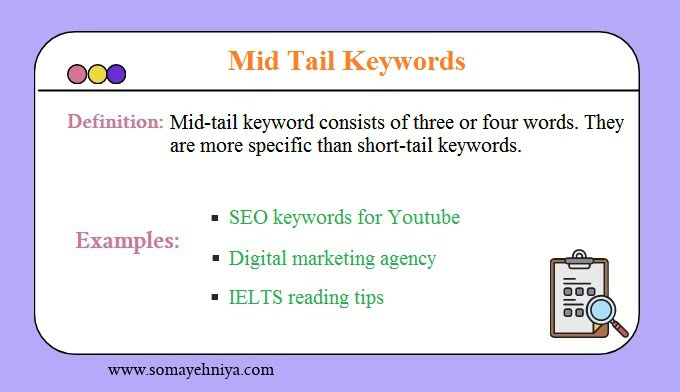
How to use mid-tail keywords: Mid-tail keywords are more specific with a midum search volume. However, they need a high or at least mid-domain authority to rank.
Long-Tail Keywords
In contrast to short-tail keywords, long-tail keywords are more specific and comprised of multiple words. These keywords usually have a lower search volume but are highly targeted.
For instance, “best running shoes for marathon training” or “affordable SEO services for small businesses” are examples of long-tail keywords. Although the search volume may be lower, the conversion rate is often higher due to more specific search intent.
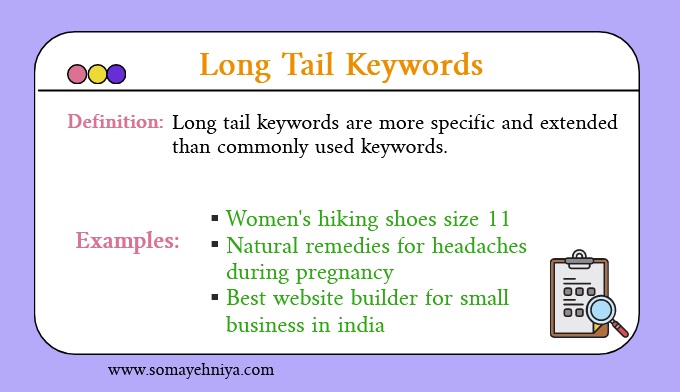
Long-tail keyword characteristics:
- More than 5 words
- Highly specific
- Low search volume
- High conversion rate
- Suitable for low DA websites
How to use long-tail keywords: These types of keywords in SEO have a crucial role, and they are suitable for every website with high or low domain authority. Websites that sell products can make the most out of long-tail keywords because the user is ready to buy something.
How to find SEO keywords by length?
Google autocomplete is a good way to find keywords by length.
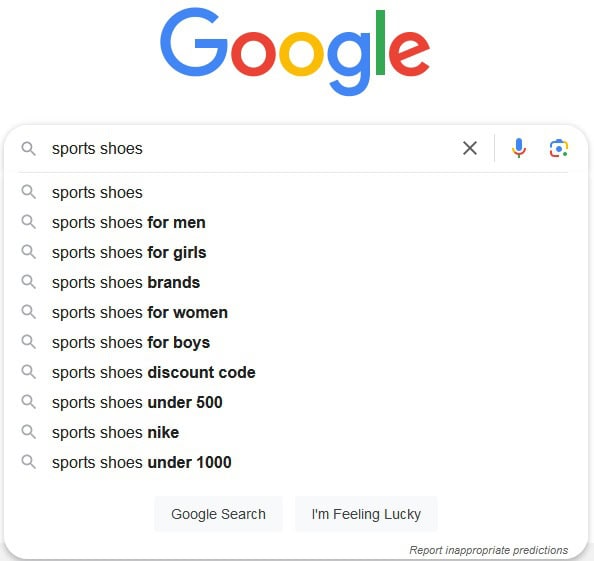
When you type a short-tail keyword in Google, it suggests other keywords with medium length. You can add more details to these medium keywords and create long-tail keywords.
Using SEO tools like Google Keyword Planner or Ahrefs is useful. These tools provide insights into the search volume and competition level of keywords.
Finding short-tail and medium-tail keywords is not difficult. But for finding long-tail keywords you need to do more research.
Forums like Quora and Reddit are good places to find long-tail keywords. Because in these forums people ask questions to solve a problem and questions are more specific by nature.
Types of keywords in SEO: By Search Intent
Understanding the intent behind users’ search queries is vital in selecting the most appropriate keywords for your SEO efforts.
There are 4 types of keywords by search intent:
- Informational
- Navigational
- Commercial
- Transactional
Before learning search intent keywords, let to take a look at the buyer’s journey. Every buyer goes through 3 steps before purchasing a product:
Awareness, Consideration, and Decision stages.
Why knowing the buyer’s journey is important?
Because every stage has a specific search intent. That’s why you should know which stage your customer is in, and accordingly select proper keywords according to search intent.
Informational keywords
These types of keywords in SEO indicate that users are seeking information or answers for their queries. These keywords usually start with “what is,” “how to,” or “benefits of.” For example, “What is SEO” or “How to bake a cake” are informational keywords.
Creating comprehensive and informative content around these keywords can help attract audiences looking for answers or guidance.
Informational keywords characteristics:
- Use question words mostly
- Look for a piece of information
- Ask a solution
- Low conversion rate
How to use informational keywords: If you want to use informational keywords, your content scope should be informational, even if your final goal is selling a product.
So, if you want to use informational content for conversion, be patient and constantly try to produce valuable content. Trust building is very important and it can’t be gained overnight.
Navigational keywords
Navigational keywords are used when individuals search for a specific website or brand. These keywords usually include the name of the website or brand they are looking for. For instance, “LinkedIn login” or “Samsung support” are navigational keywords.
Navigational keywords characteristics
- Show a brand name
- Help to Authority
How to use navigational keywords: Like informational keywords, these types of keywords may not be our primary focus. But if you have a local business, it is very vital to optimize your webpage with navigational keywords.
Commercial keywords
Commercial keywords represent an intent to research products or services before making a buying decision. They often include terms such as “best,” “top-rated,” or “reviews.” For example, “best laptops for video editing” or “top SEO agencies” are commercial keywords.
Commercial keywords characteristics:
- Signals an intention to buy
- Higher conversion rate than informational intent
- Need to compare different products
How to use commercial keywords: Based on buyers’ journey users know they what need at this stage. But need to more information to compare different products. Creating high-quality comparison articles, product reviews, or informative guides can help capture the attention of users at this crucial stage of the buyer’s journey.
Transactional Keywords
Transactional keywords indicate that users are ready to make a purchase or engage in a specific action. These keywords often include terms such as “buy,” “order,” or “discount.” For example, “buy running shoes online” or “order SEO audit” are transactional keywords.
Transactional keywords characteristics:
- Actionable by nature
- High commercial intent
- High conversion rate
How to use transactional keywords: Transactional keywords are best optimized through product pages and landing pages. Ensure that your content is persuasive, highlighting the benefits, features, and unique selling points of your product or service.
Below are some examples of search intent keywords:

How to find SEO keywords by search intent?
Understanding the search intent behind keywords requires analytical research. Tools like SEMrush or Moz Keyword Explorer can assist in identifying the search intent of specific keywords.
Search intent keywords aren’t the main keywords in your content. They come along with the main keywords to give direction to your content.
For using Semrush to find keywords by search intent, simply enter your main keyword in Semrush’s Keyword Magic Tool and select the type of search you want. It will show you many search ideas to write about it.
Additionally, you can analyze the type of content that appears in search results for a particular keyword. It provides valuable insights into the search intent.
Types of keywords in SEO: By role
There are 3 types of keywords by role:
- Primary
- Secondary
- Semantic
Primary keywords
Primary keyword (also called target keyword or seed keyword) is the major term you target in your content. It’s the heart of the content.
Every content should have at least one primary keyword, and content expand around this keyword.
Primary keyword characteristics:
- Main word of content
- Repeat constantly
How to use primary keywords: Primary keywords are repeated in titles, meta tags, subheadings, and in the body to find by search engine bots. It’s very important to consider metrics like keyword difficulty and search volume when you are going to find primary keywords. High-difficulty primary keywords will be hard to rank, especially for low-DA websites.
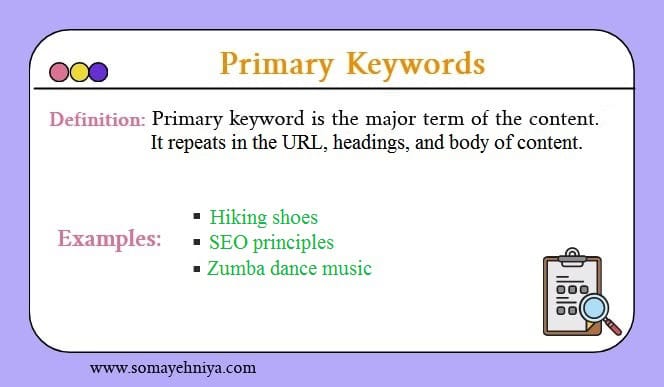
Secondary keywords
While primary keywords are the main terms that directly reflect the core topic of your content, secondary keywords cover additional context and relevant subtopics. Also, they can be synonyms of the primary keyword.
For example, if your primary keyword is “digital marketing” secondary keywords could include “digital marketing strategy,” “digital marketing
agency,” “digital marketing companies,” or “digital marketing courses.”
Secondary keywords characteristics:
- Cover relevant subtopics
- It can be a synonym of the main keyword
How to use secondary keywords: Secondary keywords are usually variations or synonyms of the main keyword. If a secondary keyword is a synonym, it’s a good chance to use it instead of the primary keyword to prevent keyword stuffing.
For ranking better you can use some secondary keywords in your content and repeat them naturally. Also, you should pay attention to the keyword difficulty of them. Lower keyword difficulty means a higher chance to rank.
Semantic Keywords
Semantic keywords (aka Latent Semantic Indexing or LSI) are a variety of related words to content and main keyword. Google bots find the relationship between words and concepts in every content. If you have these semantic words in your content, Google will understand it better.
By the way, semantic keywords are different from secondary keywords, and also it is not a synonym of the main keyword.
Semantic keywords characteristics:
- Conceptually related to main keyword
- It can be a variation of the main keyword

How to use semantic keywords: Since semantic keywords help to search bots to recognize what your content is about, so it’s better to use some of semantic keywords in subheadings and alt images. And you can incorporate them naturally in your content.
How to find keywords by role?
To find primary and secondary keywords, you can use tools like KWFinder. Simply enter your topic and give a variety of suggestions.
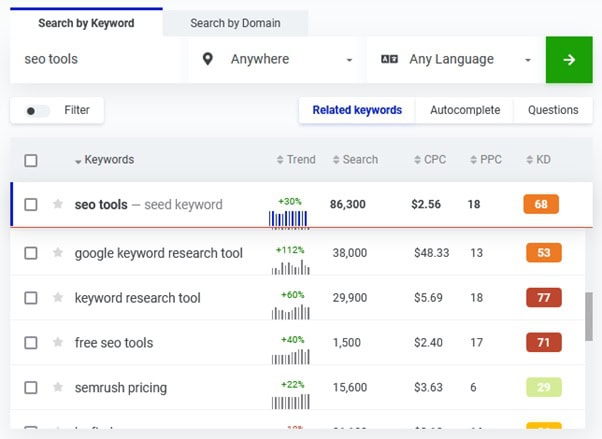
When you select one suggestion as a primary keyword, enter it in the tool to get more suggestions as secondary keywords.

To find semantic keywords you can use LSI graph tool. It’s a paid tool but there are verities of free LSI tools. .
Types of keywords in SEO: Google Ads Keywords
In addition to organic SEO, Google Ads (formerly known as Google AdWords) provides an excellent opportunity to boost your website’s visibility through paid advertising.
Why understanding Google ad keywords is crucial for marketers?
It’s obvious. If you don’t use proper keywords in ad campaigns, maybe you waste the money which cost for advertisement.
Exact match
Exact match keywords trigger ads to appear only when the search query exactly matches the keyword. There can be no additional words before or after the keyword.
For example, if your exact match keyword is “running shoes,” your ad will only appear for searches that include the exact phrase “running shoes.”
Phrase match
Phrase match keywords allow your ads to appear when the search query includes the keyword phrase in the same order. However, there may be additional words before or after the phrase.
For example, if your phrase match keyword is “running shoes,” your ad may appear for searches like “buy running shoes” or “top-rated running shoes.”
Broad match
Broad match keywords trigger ads to appear when a search query includes any word in the keyword, in any order. For example, if your broad match keyword is “SEO tools,” your ad may appear for searches like “best SEO tools,” “affordable tools for SEO,” or “types of SEO tools.”
Negative keywords
Negative keywords exclude specific terms or phrases, ensuring that your ads don’t appear for irrelevant searches. By adding negative keywords to your ad campaign, you can maximize the relevancy and effectiveness of your ad placements.
For example, if you sell running shoes but not hiking shoes, you could add “hiking” as a negative keyword to avoid showing your ad to users searching for hiking shoes.
How to use Google Ads keywords: When you create an ad campaign, you have the main keyword. Additionally, you need to select optimal keywords (ad keywords that are noted above)and Google will display your ad based on those selections.
These keywords don’t need to be researched, and the Google ads platform proposed them to you as options.
How to find SEO keywords for Google Ads?
When you use Google ads to run an ad campaign, it suggests you to select the type of keywords (exact, phrase, broad match) you need to add to your campaign. Each of them has its pros and cons:
- Broad & phrase match pulls useless queries
- Exact match misses valuable long-tail keywords
To avoid this problem you can use negative keywords to prevent useless quiries.
Types of keywords in SEO: Time-Based Keywords
There are 2 types of time-based keywords :
- Trend
- Evergreen
Trend Keywords
Trend keywords are associated with popular topics or events happening in the current moment. These keywords allow businesses to ride the wave of what’s hot and happening, and capture the attention of a wide audience.
Whether it’s the latest fashion trend, a viral social media challenge, or a breaking news story, trend keywords can help you stay relevant and drive traffic to your website.
Trend keywords characteristics
- Include a new and fresh topic
- High search volume
- Easy to rank at the early stage
How to use tend keywords: Incorporate these keywords into blog posts, articles, or landing pages that provide valuable information or insights related to the current topic or trend.
For example, if you run a technology blog, and there’s a new smartphone release generating buzz, consider creating a detailed review or comparison article using time-based keywords like “new smartphone XYZ review” or “comparison of the latest smartphones.”
Evergreen Keywords
Unlike trend keywords, evergreen keywords remain relevant and generate consistent traffic over time. They are not time-sensitive and are often associated with broader topics or evergreen content that stay relevant regardless of current trends.
Evergreen keywords are like the sturdy oak tree in the forest of search engine optimization; They provide a solid foundation for your website’s visibility.
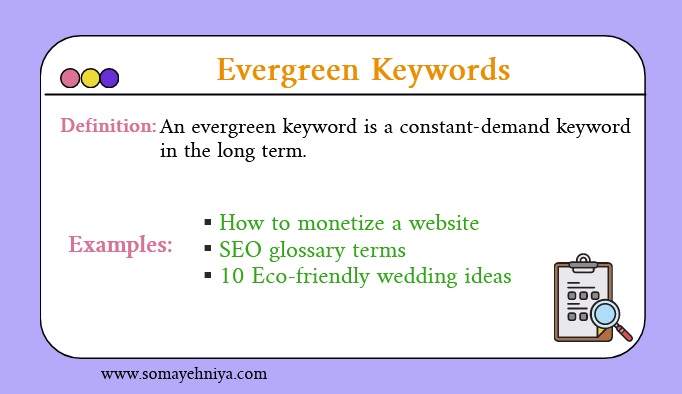
Evergreen keywords characteristics:
- High search volume
- Constant inquiry demand
- Mostly hard to rank
How to use evergreen keywords: Let’s say you own a gardening blog. While trend keywords may bring in temporary spikes of traffic, evergreen keywords like “how to grow tomatoes” or “best gardening tips” will consistently attract visitors who are interested in gardening.
By incorporating these evergreen keywords into your content, you can establish your website as a go-to resource for gardening enthusiasts.
How to find time-based keywords?
Always be updated for what happen in your industry. Using social media helps you to know about what happening. Producing content around trends keywords fast can be very effective in pulling many traffic to your website.
Google likes content about current topics. So, including trending keywords help you to rank.
Tools like Google Trends helps you to find keyword trends.

Another tool is BuzzSumo. To find trending keywords via this tool you need to log in. Then, at the top of your dashboard, on the left hand go to the Discover tab and select Trending.

On the other hand, to find Evergreen keywords, analyze your competitors’ pages. Those pages with a consistent flow of organic traffic mostly include evergreen keywords.
Types of keywords in SEO: By Target
In below you can see 4 types of keywords by target:
- Branded keywords
- Customer-defining keywords
- Market-segment keywords
- Product keywords
Branded keywords
Branded keywords are specific to a business and include the company name, product name, or any other unique identifiers associated with the brand. These keywords are essential for building brand visibility and capturing the attention of individuals already familiar with the business.
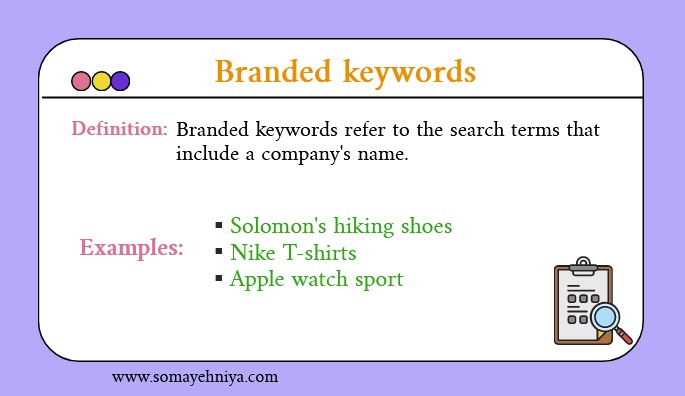
Branded keywords characteristics:
- Indicate specific brand/product
- Search volume depends on brand popularity
- Specific search intent
How to use brand name: If you are going to boost your brand, you can write articles and include your brand in them. Also if you want to know about your brand name’s popularity, type it in search engines and see the results.
Customer-defining keywords
Customer-defining keywords are another valuable addition to an SEO strategy. As the name implies, it indicates a specific group of customers. Customer-defining keyword is a good way to achieve long-tail keywords by narrowing down a broad term.
Let’s say, you have an online shop for selling shoes. Customer defining keyword will be ”sports shoes for kids”, or more specific ”sports shoes for kids 4 to 7 years”.
Customer-defining keywords characteristics:
- Medium search volume
- More conversion than broad terms
- Indicate specific audience
How to use customer-defining keywords: Types of your products and services indicate your customer-defining keywords. Based on use these keywords for those who need your product.
Additionally using customer-defining keywords helps the right audience visit your website. So, it can help to better user experience and also reduce your bounce rate.
Market-segment keywords
Market-segment keywords are specific scopes of an industry or service. Let’s say you own a shoes online shop. You have ”rubber shoes”, ”cork shoes”, ”leather shoes”. All of these are market segment keywords that have their market. These types of keywords aren’t broad so much. But it yet needs to be narrowed down if a website with low DA wants to use it.
Market-segment characteristics:
- High search volume
- Vague search intent
- Low conversion rate
How to use market-specific keywords: If you have a blog and want to use these keywords, I should say you don’t have much chance, especially if your website has low domain authority (DA). So, check keyword difficulty before using Market-segment keywords.
Product Keywords
When users search for specific products of a brand they use Product keywords. For example, they have searched for ”Samsung Galaxy A55”. This keyword shows that they are looking for a specific type of mobile phone offered by this brand.
Product keywords characteristics:
- Low search volume
- Low competitive rate
- Specific search intent
- High conversion rate
How to use product keywords: If you sell products, this type of keyword is necessary for you. Writing content about different aspects of your product helps your selling and brand awareness.
Other types of keywords in SEO
In addition to the above types of keywords, there are some other types that they not included in specific categories.
- Question-based keywords
- Geo-targeting keywords
- Competitor keywords
Question-based keywords
Question-based keywords are search queries in the form of questions. These keywords reflect the way people search for information online and can be highly valuable for businesses looking to provide helpful answers or solutions.
Question-based keywords characteristics:
- Mostly they are long-tail
- They can be both high-competition and low-competition
- Informational search intent mostly
How to use question-based keywords: The best way is to create a FAQ section at the bottom of your blog post. These questions should be as subheadings that search bots find them.
How to find question-based keywords:
Researching popular question-and-answer platforms, forums, or online communities can be incredibly useful in this regard. These platforms are a treasure of information, filled with the most frequently asked questions in your field.
Also Asked is one of the great websites to find question-based keywords. This website gets all data from Google directly
Geo-targeting keywords
Geo-targeting keywords involve keywords based on geographic locations. For instance, “SEO services in New York”, “best cafes in London”, or “best restaurants near me” are examples of Geo-targeting keywords.
Optimizing your content with Geo-based keywords can improve your visibility and attract local customers interested in your products or services.
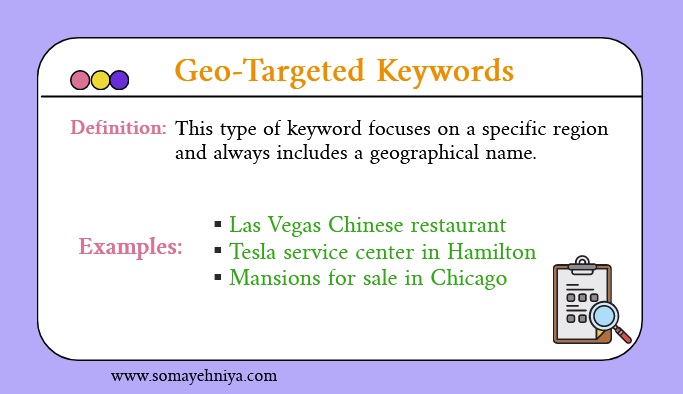
Geo-targeting keywords characteristics:
- Highly relevant traffic
How to use geo-targeting keywords: Include location-specific content and optimize your website to target a particular region or city. Promote local events, attractions, or testimonials, and match your local currency to showcase your connection to the area.
By doing so, you not only improve your search engine rankings but also build trust and credibility among local customers.
How to find geo-targeting keywords:
The geo-targeting keyword is a must-have strategy for local businesses. It’s the easiest type of keyword research. Just you need to add your region to the main keywords you are going to rank.
For example ” the best Chinese restaurant” will be ‘the best Chinese restaurant in London”, or more specifically ”the best restaurant near Westminster in London.
Competitor Keywords
Competitor keywords are another valuable strategy for your SEO. These keywords involve targeting keywords that are associated with competitors in the same industry.
Competitor’s keywords are those keywords your competitors use at the same time to generate more traffic.
How to use competitor keywords: When you find your competitor’s keywords, cluster them into different groups. Then, create content around each category and use keywords in your content.
How to find competitors' keywords:
To explore these keywords you must search online and find your competitors. SEO tools like Ahref or Semrush give you a great insight to your competitor keywords. Just don’t forget for local SEO (if your business is limited to a specific area), you need to find local competitors.
For using Ahrefs tool:
- Go to Ahrefs’ Site Explorer
- Enter competitor’s domain
- Go to the Organic keywords report

By this report, you can find the keywords that send visitors to your competitor’s webpage.
How to analyze keywords?
After you choose a keyword, it’s time to to measure some metrics. And it can’t be possible without analyzing some metrics with SEO tools.
3 factors must analyze carefully to choose the best keywords:
- Cost per click
- Keyword difficulty
- Search volume
If a website has high authority, ranking becomes easier. So, website with lower authority should be careful to choose easy keywords to rank.
Cost per click
Cost Per Click (CPC) is a metric used in SEO to measure the cost of each click on an advertisement. CPC is calculated by dividing the total cost of the ad campaign by the number of clicks it generates. This metric is commonly used in pay-per-click (PPC) advertising, where advertisers pay for each click their ads receive.
Keywords with higher CPCs tend to have high competition. So, target low CPC keywords, for example use long-tail keywords, which are more specific and have lower competition.
Search volume
Search volume is the number of times a given word has been searched in a search engine. You can find search volume by using some free tools like Google Keyword Planner. The search volume measurement metric is monthly mostly.
A higher search volume isn’t suitable for ranking especially when you’re inexperienced in this field.
So, it is better to focus on low-volume keywords under special circumstances.
One of the low-volume keywords is long tail keywords.
Keyword difficulty
Keyword difficulty (KD) refers to the level of difficulty in ranking for a given keyword. It is measured on a scale from 0 to 100, the latter being the hardest to rank for.
Keyword difficulty can measure with SEO tools like Google Planner. This measurement may be different from one tool to another. That means each tool maybe has various variables to measure keyword difficulty.
The higher keyword difficulty means a higher difficulty to rank it.
When you enter a keyword in Google Keyword Planner, it shows different URLs that have ranked for this keyword. The level of difficulty is different from one URL to another.
Where is the best place to put keywords?
After analyzing and choosing keywords, you should place them in the right spot in your content. This step is very critical. Otherwise, all of your efforts will destroy.
Title Tag
The most important spot for your keyword is in the title tag. A title tag is a blue part that appears on a search engine result page when users enter a query.
If your keywords don’t include in the title tag, you lose the chance to rank. In HTML it shows as title of a webpage.

Headline
Headlines serve as the first point of contact between a page and its audience, making them a crucial aspect of search engine optimization. It is the first title on the top of your web page and is different from the title tag. In fact, Headline serves as the H1 of a webpage in HTML.
Using keywords in headlines is effective for Google bots to find your page, and also people understand the gist of the whole of your content.
Incorporating relevant and well-researched keywords into your headlines is an essential aspect of effective SEO. It can improve your rankings and helps to attract more targeted traffic.
Meta Description
Meta description is a HTML attribute that provide a brief summary of the content on a webpage. It appears below the page title in search engine results and can greatly impact click-through rates.
To optimize Meta descriptions for SEO, it’s essential to include relevant keywords. These keywords should accurately reflect the content on the page and match the user’s search query.
Including keywords in meta descriptions helps search engines understand what the page is about and can improve its visibility in search results.
First Paragraph
Using keywords in first paragraph is necessary. Because search engines give more weight to the first few sentences of a page or article when determining its relevance to a particular search query.
When incorporating keywords into the first paragraph, it’s crucial to ensure that they flow naturally and don’t disrupt the overall readability of the content. Keyword stuffing can actually harm your SEO efforts by making your content appear spammy and low-quality.
Anchor Text
Anchor text refers to the clickable text that appears as a hyperlink on a webpage. By including relevant keywords in the anchor text, you can signal to search engines what the linked page is about and improve its ranking for those specific keywords.
However, it’s important to use anchor text strategically and not overdo it. Overusing keywords in anchor text, also known as keyword stuffing, can actually harm your SEO efforts by appearing spammy to search engines.
Image Alt Text
Image alt text is HTML attribute that is written for an image in webpage. Alt text has this potential to improve your ranking page when add your keyword to it.
Just be noted use more specific keywords for your alt text. Shot tail keywords don’t help to your SEO ranking. Pay attention to below image.

Good: <img src = “image.png” alt = “a little girl in green grass”>
Better: <img src = “image.png” alt = “a girl in black dress in green grass”>
Best: <img src = “image.png” alt = “a girl in black dress running in green grass”>
Conclusion
Keep it in your mind that keyword research is an ongoing process. As search trends and user behavior change over time, your approach to keyword research should be change too.
Ultimately, effective keyword research requires a combination of technical expertise, creativity, and a deep understanding of your target audience.
By taking the time to conduct thorough research and develop a comprehensive strategy, you can position your business for long-term success in the highly competitive world of SEO.
FAQs
How do I choose the right keywords for SEO?
- Start by brainstorming a list of relevant keywords to your niche.
- Use keyword research tools such as Google Keyword Planner to determine the search volume and competition level for each keyword.
- Consider the intent behind each keyword. It helps you tailor the content to meet the needs of your target audience
- Ensure the keyword relevancy. The keywords you choose should be directly related to the content on your website or the products/services you offer.
- Finally, regularly monitor and adjust your keyword strategy based on changes in search trends and your own website analytics.
What types of keywords should I use for SEO?
Keywords with medium search volume and a low competition is the best keywords.
Long-tail keywords are good choice since they are more generic keywords and easier to rank.
How often should I update my SEO keywords?
If you’re in a highly competitive industry where new products or services are introduced frequently, then you may need to update your keywords more frequently. On the other hand, if your industry is relatively stable, then updating your keywords every few months may suffice.
How can I measure the success of my SEO keywords?
By regularly assessing keyword rankings, organic traffic, and user engagement metrics, you can informed about success of your SEO keywords and accordingly optimize your content and improve your overall search visibility.

